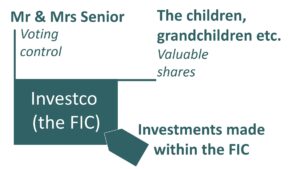Tax Tuesday has previously referred to the Family Investment Company (FIC) – a popular ownership vehicle in estate planning and Inheritance Tax management solutions, typically as an alternative to a trust, with a list of compelling advantages.
Today, we will explore the key features and benefits of the FIC as a start-point for clients and prospects who might be thinking about their estates. The FIC has become increasingly popular in recent years as a tool for managing investments on behalf of family members and managing the senior members’ taxable estates.
There are a number of important reasons, outlined briefly below, why the FIC is an attractive alternative to other vehicles which might undertake the same, or similar, roles.
This is the classic and simplest depiction of the FIC:

There are different ways the FIC structure can be established and different “bolt-ons” which can be added to extend its role and scope. The classic arrangement outlined above performs the following:
- Mr & Mrs Senior have transferred monies (only monies which they can afford to give away) to/for the benefit of their children and grandchildren etc. Those monies are injected into a FIC;
- Mr & Mrs Senior have made the above transfer on the basis of “Potentially Exempt Transfers” (PETs) such that those gifts will only become chargeable to Inheritance Tax (IHT) in the event of their death(s) within the seven years following the gift(s);
- Mr & Mrs Senior retain control over all of the value which is contained within the FIC through one or more special shares which confer voting rights (or through their directorships of the FIC);
- The monies invested in the FIC are invested according to Mr & Mrs Senior’s wishes with due regard to what they wish to achieve for their descendants and when;
- Mr & Mrs Senior decide when (and how) to turn on the “tap” to allow value to flow from the FIC to any (or all) of their descendants in order to meet the needs or wishes of those individuals.
The classic structure boasts a number of important advantages which help to explain its popularity in recent years:
- The use of PETs means that unlimited amounts of value can be transferred into this structure without any IHT charges (unlike gifts into trust which are subject to lifetime IHT charges at 20% where they exceed each transferor’s £325,000 nil rate band in any seven year period).
- The FIC is a normal limited company which is generally understood by most, if not all, of those who decide to use it (unlike trusts which can be inhibiting to many because they are relatively unfamiliar).
- As a normal UK limited company, the FIC is subject to a relatively benign tax regime with all taxable profits, income and gains taxed at a tolerable 19% (the lowest rate among the G20).
- Furthermore, where equities are to be part or all of the investments to be made by the FIC, dividend income is normally exempt from Corporation Tax.
- A UK limited company is not subject to the IHT regime which applies to a trust – so no “ten-year anniversary charges” or “exit charges” apply to capital extracted.
- In view of the way the monies are injected into the FIC, value can come out to the descendants in either capital or income form, as the controlling shareholders dictate, often with a view to minimising the taxation consequences for those recipients.
- Capital can often come out tax free; income can often take advantage of the recipients’:
- dividend nil rate bands;
- personal allowances; and
- basic rate bands, within which they are taxed at just 7.5%.
- Where a formal trust arrangement can be beneficial, notwithstanding the existing benefits of a FIC, this can be established to hold some of the “valuable shareholdings” (per the diagram above) on behalf of some (or all) of the descendants in question.
Contact us
A FIC provides a potentially very effective and tax efficient investment vehicle in which control continues to be exercised in full by the senior generation (normally) without IHT costs (on the way in, or on the way out) with low taxation suffered inside the FIC and low taxation in extracting value for use by the descendant beneficiaries when the time is right.
For more information, please do not hesitate to email tax@haroldsharp.co.uk to discuss.

